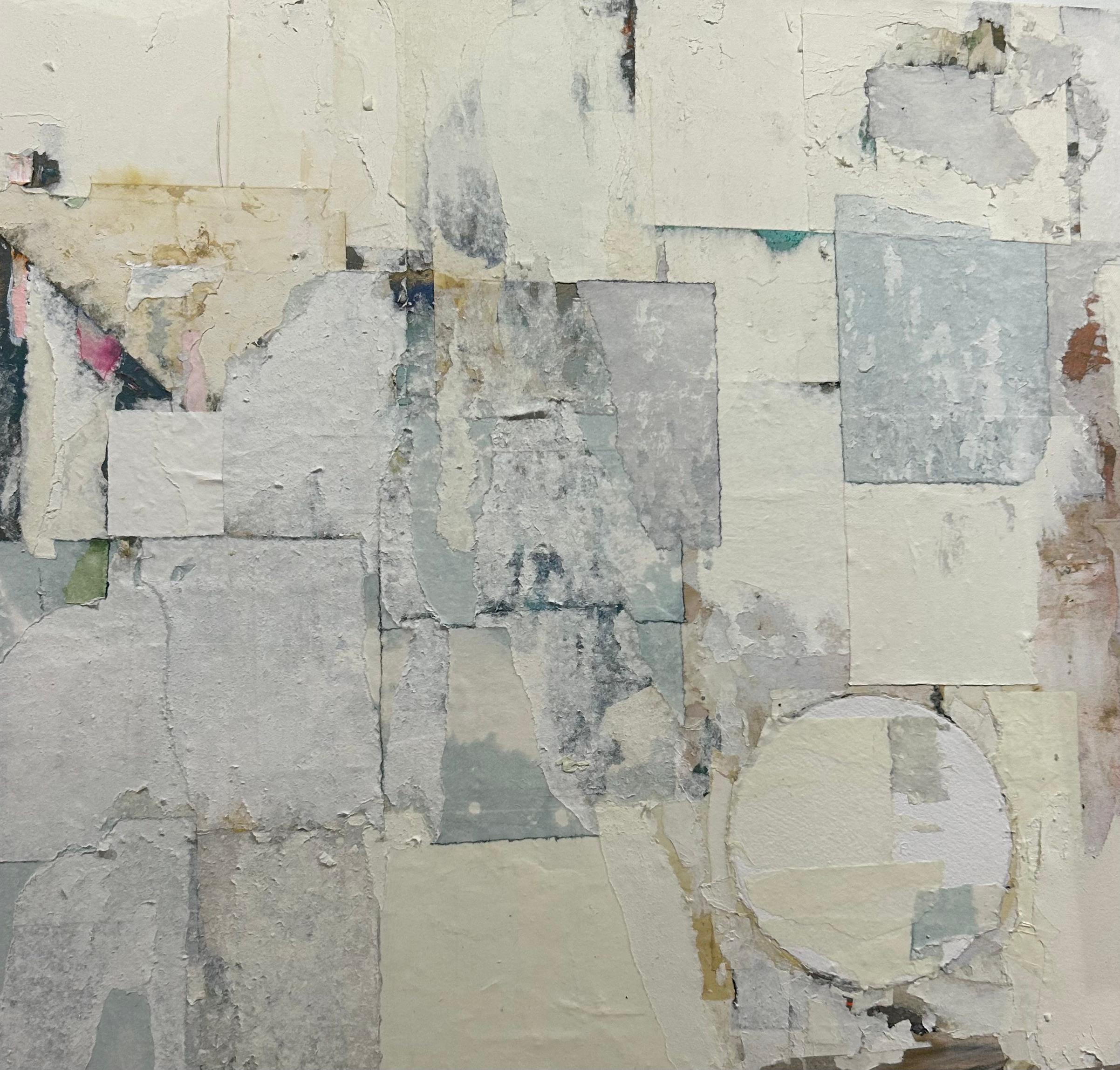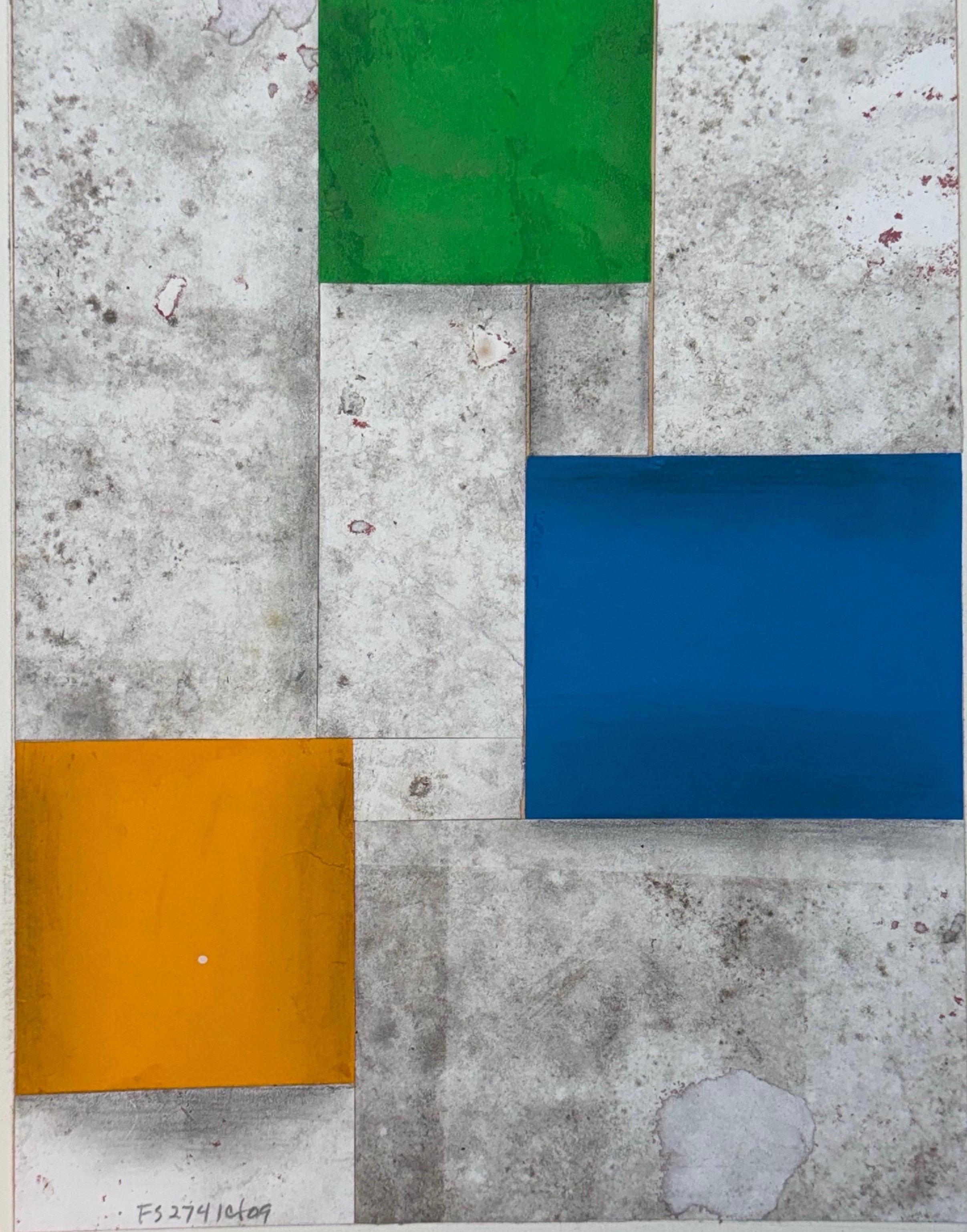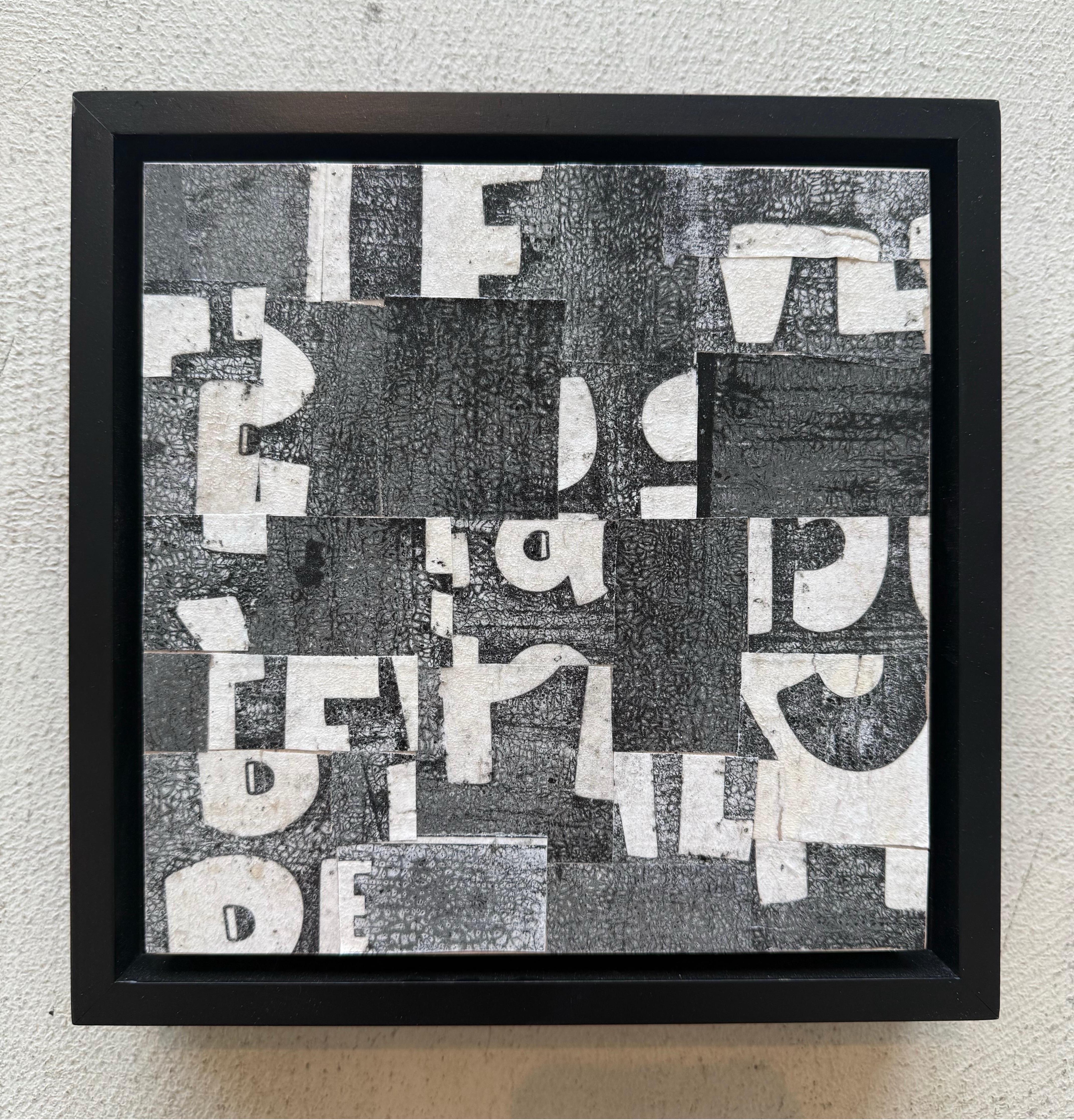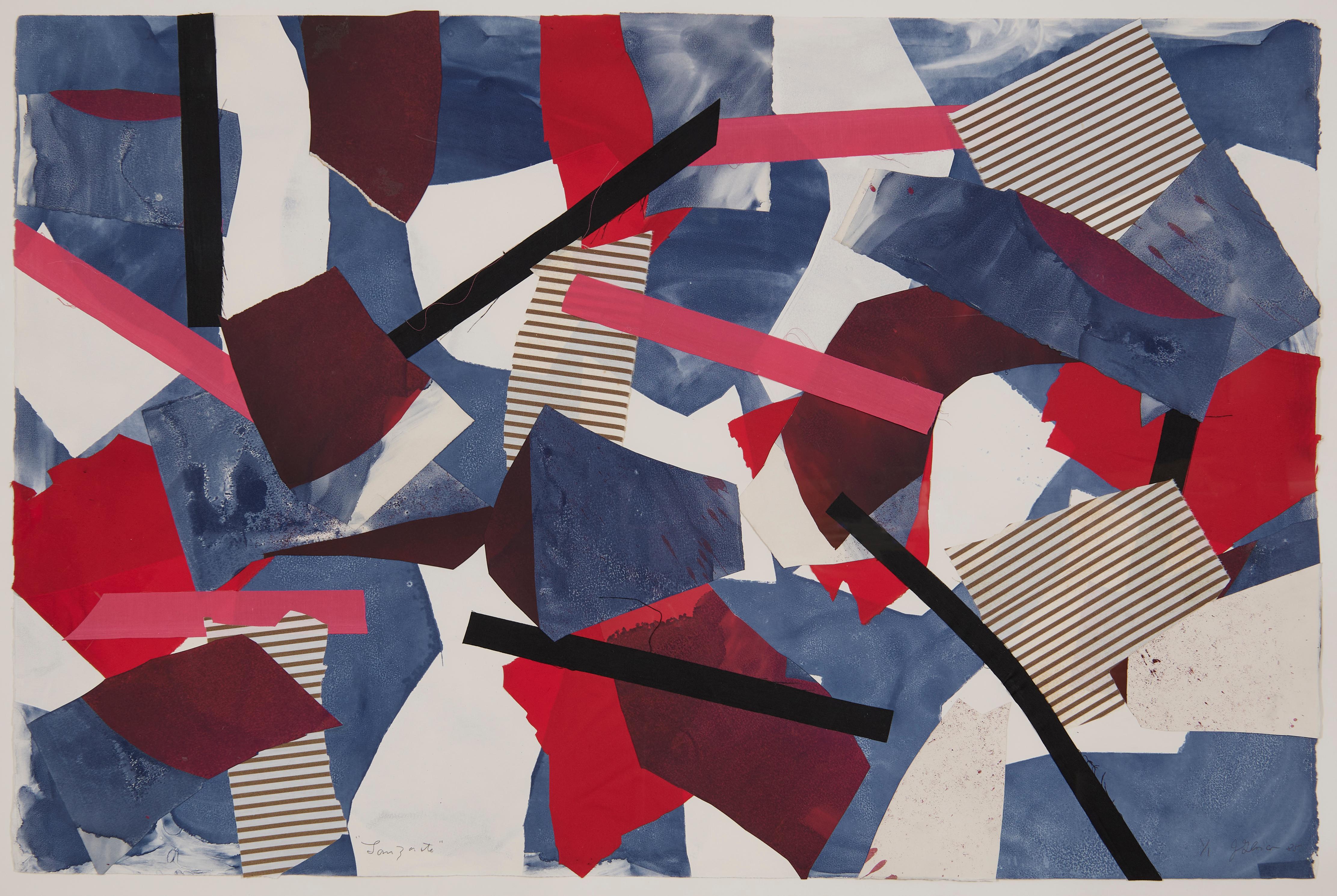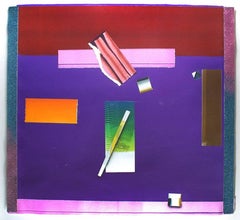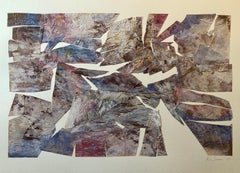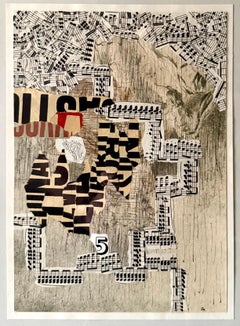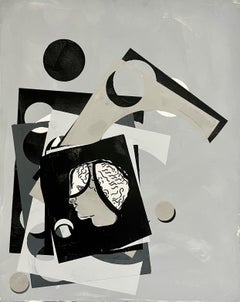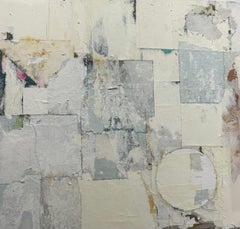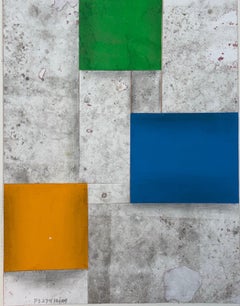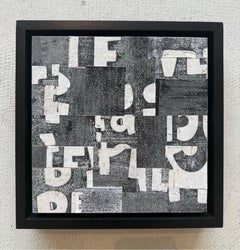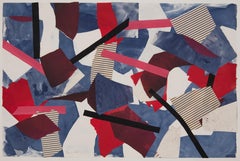Items Similar to Abstract Cubist Composition Collage Stencilled Letters Numbers Assemblage
Want more images or videos?
Request additional images or videos from the seller
1 of 5
Enid MunroeAbstract Cubist Composition Collage Stencilled Letters Numbers Assemblage
$3,000
£2,327.97
€2,628.44
CA$4,292.72
A$4,684.14
CHF 2,423.43
MX$56,036.40
NOK 30,613.66
SEK 28,745.75
DKK 19,629.74
About the Item
Genre: Modern
Subject: Other
Medium: Other, Acrylic
Surface: Paper
Country: United States
Dimensions: 30" x 23 1/4"
Dimensions w/Frame: 33 3/4" x 26 3/4"
Mixed Media Abstract Collage, torn paper, drawings and painting.
Enid Munroe re-establishes the aesthetic worth of ordinary manufactured objects within the basic form language of Cubism. In this painting the artist uses trompe-l'oeil to render her composition, involving realistic imagery in order to create the optical illusion that the depicted objects exist in three dimensions.
Enid Munroe is an artist and teacher who is well known regionally for her paintings, works on paper and Gold leaf, silver leaf, assemblage series. She has been included in numerous invitational and juried exhibitions both nationally and regionally. Her works are in leading public, corporate and private collections including the Brooklyn Museum and the National Museum of American Art.
She is the author of An Artist in the Garden: A Guide to Creative and Natural Gardening (Henry Holt & Co, 1994) and has been active in regional art events including the founding of the annual Pequot Library Art Show, Southport. She is a member of Westport Arts Center and a former trustee of Silvermine Guild.
- Creator:Enid Munroe (1923, American)
- Dimensions:Height: 33.75 in (85.73 cm)Width: 26.75 in (67.95 cm)
- Medium:
- Movement & Style:
- Period:
- Condition:
- Gallery Location:Surfside, FL
- Reference Number:1stDibs: LU38212019622
About the Seller
4.9
Platinum Seller
Premium sellers with a 4.7+ rating and 24-hour response times
Established in 1995
1stDibs seller since 2014
1,833 sales on 1stDibs
Typical response time: 1 hour
- ShippingRetrieving quote...Shipping from: Surfside, FL
- Return Policy
More From This Seller
View AllLarge Assemblage Collage Monotype California Art from Styria Studios
By Paul Sarkisian
Located in Surfside, FL
Framed in a shadow box. size includes frame. Paul Sarkisian (1928-) is an American artist who made significant contributions during the growth of contemporary art in Los Angeles, th...
Category
1980s 85 New Wave Mixed Media
Materials
Glitter, Mixed Media, Archival Paper
MIxed Media Collage Assemblage Abstract Painting Pioneering Female Aviator
By Vera Simons
Located in Surfside, FL
This is an Abstract Expressionist torn and folded paper painted collage. The paper is metallicized through some process. they are very luminous and beautiful. it is mounted on heav...
Category
1970s Abstract Expressionist Abstract Paintings
Materials
Paint, Mixed Media, Laid Paper
Original Guggenheim Museum Exhibited Jiri Kolar Collage Art Abstract Music Notes
By Jiri Kolar
Located in Surfside, FL
Jiri Kolar, Czech (1914-2002)
"Musical Notes"
Paper Collage & Ink on Paper
Hand signed with Initials Lower Right.
Dimensions: Sight-7.5" x 11". Frame-17" x 21"
Circa: 1960's-1...
Category
20th Century Contemporary Mixed Media
Materials
Paper, Mixed Media
American Figurative Abstract Geometric Mixed Media Painting Judy Rifka
By Judy Rifka
Located in Surfside, FL
Judy Rifka, American, 1945
Laborde Head
Mixed Media on Canvas (acrylic paint and ink)
1989
Hand signed, titled, and dated verso
30 X 24 inches
Provenance: The Estate of Theodore A Bonin.
(Ted Bonin was a principal in Alexander and Bonin, a New York gallery known for its diverse slate of conceptual artists. He started at Marlborough gallery London in the 60s, then in partnership with Brooke Alexander. In its stable were a host of esteemed artists: Willie Cole, Rita McBride, John Ahearn, Paul Thek...
Category
1980s Abstract Geometric Abstract Paintings
Materials
Canvas, Mixed Media, Ink, Acrylic
1980s Abstract Expressionist Pop Art Painting Collage, Assemblage Hugh O'Donnell
By Hugh O'Donnell
Located in Surfside, FL
This is a mixed media collage with an almost sculpture quality to it. it is hand signed. size includes frame.
Hugh O'Donnell is an English painter, printmaker and site-specific art...
Category
1980s Pop Art Abstract Paintings
Materials
Charcoal, Acrylic, Archival Paper
1985 Abstract Geometric Monoprint Painting Chine Colle Collage Robert Kelly
By Robert Kelly
Located in Surfside, FL
Robert Kelly (American, 1956-)
Abstract Monoprint
1985
Pencil titled Donja XI and dated 1985 lower left
Hand signed lower right
Provenance: from the collection of a prominent US corporation.
Dimensions:
Sheet: 33.5" X 28"
Image: 26" X 22"
Robert Kelly (born 1956) is an American artist. He is based in New York City.
Kelly was born in Santa Fe, New Mexico, and studied at Harvard University, Cambridge, Massachusetts (B.A. 1978). His paintings have been acquired by public and private collections in Europe and the United States, including The Whitney Museum of American Art, New York, NY; The Brooklyn Museum, Brooklyn, NY; The Museum of Fine Arts, Santa Fe, NM; Milwaukee Art Museum, Milwaukee, WI; Smith College Art Museum, Northampton MA; Jane Voorhees Zimmerli Art Museum, Rutger’s University, NJ; Montgomery Museum of Fine Arts, Montgomery; The Fogg Museum, Cambridge, MA; The Margulies Collection, Miami, FL; and the McNay Art Museum, San Antonio, TX.
Kelly has traveled throughout the United States, Europe, North Africa, the Near East, and Nepal. His work often incorporates unusual materials from his journeys, among them vintage posters and printed antique paper, obscured and layered in saturated pigments on a canvas faintly scored with irregular grids. Kelly’s paintings have been likened to palimpsests and his method described as one of building “meticulously on inhabited ground, layering materials, documents, and signs, covering them, wiping out their beauty, nearly, but allowing something of the labor and their languages to persist.”
Kelly worked as a commercial photographer for Polaroid in Cambridge, Massachusetts, and completed residencies at The MacDowell Colony and The Karolyi Foundation, Vence, France, before devoting himself entirely to painting in 1982. His work has been the subject of more than forty-five solo shows at venues in North America and Europe, including Spazio Bianco/AR Contemporary Art, Milan, Italy; Leslie Feely Fine Art, New York; and The John Berggruen Gallery, San Francisco, California. He has participated in more than one hundred group shows in the United States and abroad. including the Projects Inaugural Exhibition at Bentley Gallery Featuring works by Jim Dine...
Category
1980s Abstract Abstract Prints
Materials
Monoprint, Monotype
You May Also Like
Multimedia Nature Collage on Canvas
Located in New York, NY
Nancy Pantirer
Untitled
Mixed Media on Canvas
50 x 47 in
Nancy Pantirer incorporates abstract expressionism and collage into her canvases, letting the properties of paint and paper ...
Category
21st Century and Contemporary Abstract Geometric Mixed Media
Materials
Canvas, Acrylic, Laid Paper
Original Collage on Paper Titled: Fs 2741 ct09
By Cecil Touchon
Located in West Palm Beach, FL
paper size: 15 x 19, art size: 9 x 12
Cecil Touchon Born 1956 Austin, Texas is a contemporary American collage artist, painter, published poet and theorist living in Pagosa Springs,...
Category
2010s Abstract Geometric Abstract Paintings
Materials
Acrylic, Laid Paper, Magazine Paper
Original Collage on Canvas Titled: PDP 1359 ct23
By Cecil Touchon
Located in West Palm Beach, FL
Post Dogmatist Painting on Panel, signed verso
Art is 8 x 8 with frame approximately 9.5 x 9.5
ready to hang
Cecil Touchon Born 1956 Austin, Texas is a contemporary American collage...
Category
2010s Abstract Geometric Abstract Paintings
Materials
Acrylic
Lanzorate, Large Abstract Collage, New York Artist
By Joseph Glasco
Located in Beachwood, OH
Joseph Glasco (American, 1925-1996)
Lanzorate, 1985
Monotype with fabric collage and mixed media on paper
Signed and dated lower right, 1/1, titled lower left
31.5 x 48 inches
37 x 5...
Category
1980s Abstract Mixed Media
Materials
Fabric, Paper, Monotype
British mid century 3D collage by Cornish artist David Andrew, 2/25
Located in Petworth, West Sussex
A beautiful 3D abstract collage in different materials in muted colours by Cornish artist David Andrew.
Andrew was born in Redruth, Cornwall, one of the few internationally recogn...
Category
20th Century Abstract Mixed Media
Materials
Paper
Untitled I, Abstract Collage and Acrylic Work on Paper by Frank Rowland
By Frank Rowland
Located in Long Island City, NY
Artist: Frank Rowland, American (1927 - )
Title: Untitled I
Year: circa 1980
Medium: Acrylic and Collage on Paper, signed
Size: 31.5 x 32 in. (80.01 x 81.28 cm)
Category
1980s Abstract Mixed Media
Materials
Acrylic, Archival Paper
